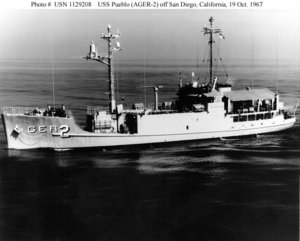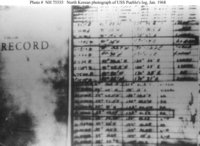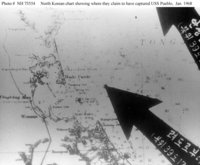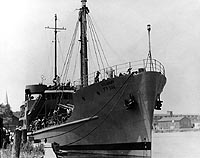USS Pueblo (AGER-2)
|
|
USS Pueblo, AGER-2 is a United States ship, famous for being boarded and captured by soldiers of North Korea in 1968 in what is known as the Pueblo incident.
The ship was launched at the Kewaunee Shipbuilding and Engineering Company Kewaunee, Wisconsin on 16 April 1944 as U.S. Army cargo ship FS-344. She was transferred to the US Navy in 1966 and renamed USS Pueblo. Initially, she served as a light cargo ship, AKL-44, but shortly after resuming service was converted to an intelligence gathering ship and re-designated AGER-2 on 13 May 1967. AGER (Auxiliary General Environmental Research) denoted a joint Naval and National Security Agency (NSA) program. Pueblo displaced 895 tons (909 metric tons) and was powered by twin diesel engines giving her a top speed of 12.7 knots (23.5 km/h). She was armed with two Browning .50 caliber machine guns, and had accommodations for 6 officers and 70 enlisted men.
After training operations off the US West Coast, Pueblo left for Yokosuka, Japan on November 6, 1967. She arrived at Pearl Harbor, Hawaii on November 13, 1967.
The USS Pueblo, still held by North Korea, remains a commissioned vessel of the US Navy.
| Contents |
Activity and conflict near Korea
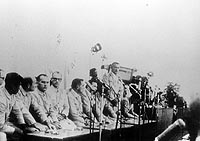
In January 1968, North Korean forces seized the Pueblo. US Naval authorities insist that before the capture, Pueblo was miles outside North Korean territorial waters. The crew affirms the assertion that the spy ship was operating from international waters. The mission statement allowed her to approach within a nautical mile (1.9 km) of that limit.
On January 5, 1968, Pueblo left for Sasebo, Japan. She left Sasebo on January 11 with specific orders to intercept and conduct surveillance of Soviet naval activity in the Tsushima Straits and to gather signal and electronic intelligence.
On January 21 a modified Soviet style subchaser, SO-I class, passed within two miles (4 km) of the Pueblo.
The next day, two North Korean fishing trawlers (Lenta Class) passed within 25 yards of Pueblo. That day, a North Korean unit made an assassination attempt against South Korean leadership targets, but the crew of Pueblo was not informed.
The following day, January 23, Pueblo was approached by a subchaser and her nationality was challenged, Pueblo responded by raising the US flag. The North Korean vessel then ordered her to stand down or be fired upon. Pueblo attempted to maneuver away, but was considerably slower than the subchaser. Additionally, three torpedo boats appeared on the horizon and then joined in the chase and later attack. The attackers were soon joined by two MiG-21 fighters. A fourth torpedo boat and a second subchaser appeared on the horizon a short time later. The ammunition on Pueblo was stored below decks, and her machine guns were wrapped in cold weather tarpaulins. The machine guns were unarmored, and no attempt was made to man them.
The North Korean vessels attempted to board Pueblo but she maneuvered to prevent this and a subchaser opened fire with a 55 mm cannon. The smaller vessels fired machine guns into Pueblo, which then signalled compliance and began destroying sensitive material. The volume of material on board was so great it made it impossible to destroy all of it.
Radio contact with Naval Security Group in Kamiseya, Japan had been ongoing. Seventh Fleet command was aware of Pueblo’s situation. Help was promised but never arrived. More than likely, no one wanted to take responsibility for an attack on North Korean vessels attacking Pueblo. By the time President Lyndon Johnson was awoken, Pueblo had been captured and any rescue attempt would be futile.
Pueblo followed the North Korean vessels as ordered, but then stopped immediately outside North Korean waters. She was again fired upon, and a US sailor, Seaman Duane Hodges, was killed. She was boarded by men from a torpedo boat and a subchaser. Crew members had their hands tied, were blindfolded, beaten with AK-47s and prodded with bayonets.
Once Pueblo was in North Korean territorial waters, she was boarded again, this time by high ranking North Korean officials.
Aftermath
K64711t.jpg
upon release December 23, 1968
Pueblo was taken into port at Wonsan and the crew moved to POW camps, with some POWs reporting on release they were starved and regularly tortured while in North Korean custody. This treatment was allegedly worsened when the North Koreans realised that crewmen were secretly giving them "the finger" in staged propaganda photos.[1] (http://groups.msn.com/ctoseadogs/usspueblocrew1.msnw) In fact, one of these photographs-- which at a glance shows the crew relaxed and smiling-- covertly used sign language to convey the message "SNOWJOB" (an American colloquialism for a lie or cover-up). The photograph was presented to the west as an example that the crew had supposedly decided to defect. The message was subsequently detected, however, and stands as an excellent, if unconventional, example of steganography.
Following a written admission by the US that Pueblo had been spying, and an apology, the North Korean government decided to release the 82 remaining crew members. On December 23, 1968, the crew was trucked to the DMZ border with South Korea and ordered to walk south across the "Bridge of No Return", exactly 11 months after being taken prisoner. The US then retracted the admission and apology. Commander Lloyd M. Bucher, commanding officer of the Pueblo and the ship's executive officer, Lt. Ed Murphy and communications officer, Lt. Steve Harris, appeared before a Navy Court of Inquiry. A court martial was recommended for all of them but the Secretary of the Navy, John H. Chafee, rejected the recommendation. Commander Bucher was never found guilty of any indiscretions (although he received an official letter of reprimand) and the general consensus amongst military personnel is that he was treated unfairly. Bucher had followed his orders, which clearly dictated that he not spark an international incident. No combat resulted from the capture of the Pueblo. Bucher died in San Diego on January 28, 2004, partly resultant from complications from the injuries he'd suffered of his time as a prisoner-of-war in North Korea.
Pueblo is still held by North Korea. In October 1999 she was moved from Wonson on the east coast, to Nampo on the west coast. This required moving the vessel through international waters, and it was done just before the visit of US presidential envoy James Kelly to the capital Pyongyang. The present location of Pueblo is in Pyongyang.
Pueblo remains a commissioned ship in the US Navy. She is widely believed to be the first American ship to have been captured since the wars in Tripoli, but that is incorrect. On December 8, 1941, the river gunboat USS Wake (PR-3) was captured by Japanese forces while moored in Shanghai.
Tourist attraction
The USS Pueblo is one of the primary tourist attractions in Pyongyang, North Korea. Often tourists are lead through the ship by a guided tour. Participants will first enter the ship for a 15-minute video shown from a small TV set mounted in the ceiling, explaining how the North Koreans captured the ship, with some old film footage from that time. All areas of the ship is shown, including the secret communications room full of encryption machines and radio equipment, still in a partly dissassembled state after they were inspected by North Korean technicians. The highlight of the guided tour is a photo opportunity where visitors can have their pictures taken while holding the forward-mounted machine-gun.
Pueblo-guided-tour.jpg
See also
External links
- official US Navy registry (http://www.nvr.navy.mil/nvrships/details/AGER2.htm)
- site maintained by former Pueblo crew members (http://www.usspueblo.org/)
- a photograph on board (http://www.bbc.co.uk/radio3/world/northkoreaphotos11.shtml)
- CNN.com obituary for Commander Lloyd M. Bucher (http://www.cnn.com/2004/US/West/01/29/obit.bucher.ap/index.html)

